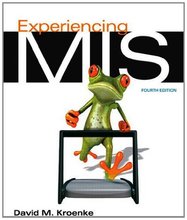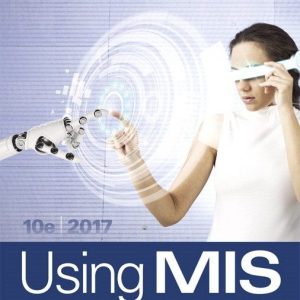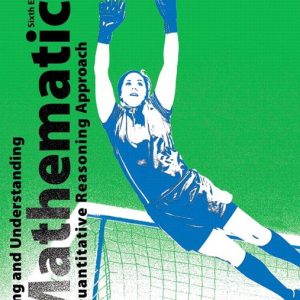This is completed downloadable of Experiencing MIS Kroenke 4th Edition Test Bank

Product Details:
- ISBN-10 : 0132967480
- ISBN-13 : 978-0132967488
- Author:
Directed primarily toward students taking an undergraduate Introduction to Management Information Systems course, this text also provides practical content to current and aspiring industry professionals.
This modular text shows students how businesses use–and need–information systems to accomplish their goals, objectives, and competitive strategy.
Table of Content:
- PART 1 Why MIS?
- This Could Happen to You
- CHAPTER 1 The Importance of MIS
- This Could Happen to You
- Study Questions
- Q1 Why Study Management Information Systems (MIS)?
- What Are Cost-Effective Business Applications of Facebook and Twitter (or Whatever Will Soon Appea
- How Can I Attain Job Security?
- How Can MIS Help You to Learn Non-routine Skills?
- Jobs
- What Is the Bottom Line?
- Q2 What Is an Information System?
- Q3 What Is MIS?
- Experiencing MIS Inclass 1 Information Systems and Online Dating
- Management and Use of Information Systems
- Achieving Strategies
- Q4 Why Is the Difference Between Information Technology and Information Systems Important to You
- Ethics Guide Ethics and Professional Responsibility
- Q5 What Is Your Role in IS Security?
- Strong Passwords
- Password Etiquette
- Guide Five-Component Careers
- How does the knowledge in this chapter help Kerrie and you?
- Active Review
- Key Terms and Concepts
- Using Your Knowledge
- Collaboration Exercise 1
- CASE STUDY 1 Requirements Creep at Australia’s Parliament House
- CHAPTER 2 Business Processes, Information Systems and Information
- This Could Happen To You
- Study Questions
- Q1 Why Does $RU Need to Understand Business Processes?
- Q2 How Can Business Process Modelling Help Organisations?
- Q3 How Can Information Systems Improve Process Quality?
- What Is Process Quality?
- Using Information Systems to Improve Process Quality
- Experiencing MIS Inclass 2 CatchoftheDay
- Q4 What Is Information?
- Q5 What Data Characteristics Are Necessary for Quality Information?
- Guide Understanding Perspectives and Points of View
- Accurate
- Timely
- Relevant
- Just Barely Sufficient
- Worth Its Cost
- How does the knowledge in this chapter help Kerrie and you?
- Green IT Guide ‘Whole-of-Government’ Approach To Green IT
- Active Review
- Key Terms and Concepts
- Using Your Knowledge
- Collaboration Exercise 2
- CASE STUDY 2 Justicelink System Problems
- CHAPTER 3 Organisational Strategy, Information Systems and Competitive Advantage
- This Could Happen To You
- Study Questions
- Q1 How Does Organisational Strategy Determine Information Systems Requirements?
- Q2 What Five Forces Determine Industry Structure?
- Q3 What Is Competitive Strategy?
- Q4 How Does Competitive Strategy Determine Value Chain Structure?
- Primary Activities in the Value Chain
- Support Activities in the Value Chain
- Value Chain Linkages
- Ethics Guide Yikes! Bikes
- Q5 How Do Value Chains Determine Business Processes and Information Systems?
- Experiencing MIS Inclass 3 Competitive Strategy over the Web
- Q6 How Do Information Systems Provide Competitive Advantage?
- Competitive Advantage via Products
- Competitive Advantage via Business Processes
- How Does an Actual Company Use IS to Create Competitive Advantage?
- How Does This System Create a Competitive Advantage?
- Guide Your Personal Competitive Advantage
- How does the knowledge in this chapter help Kerrie and you?
- Active Review
- Key Terms and Concepts
- Using Your Knowledge
- Collaboration Exercise 3
- CASE STUDY 3 Competitive Advantage at National Australia Bank
- PART 1 Review
- Consider Your Net Worth
- Application Exercises
- PART 1 CASE STUDY Innovation in Information Systems
- PART 2 Information Technology
- This Could Happen To You
- CHAPTER 4 Hardware and Software
- This Could Happen To You
- Study Questions
- Q1 What Do Business Professionals Need to Know about Computer Hardware?
- Basic Components
- Computer Data
- How a Computer Works, in Fewer than 300 Words
- Why Should a Manager Care How a Computer Works?
- What is the Difference Between a Client and a Server?
- Q2 What Do Business Professionals Need to Know about Operating Systems Software?
- Experiencing MIS Inclass 4 Innovation in Practice: Microsoft Surface
- Green IT Guide NAB Data Centres
- What Are the Major Operating Systems?
- Non-Mobile Client Operating Systems
- Mobile Client Operating Systems
- Server Operating Systems
- Virtualisation
- Owning versus Licensing
- Q3 What Do Business Professionals Need to Know about Applications Software?
- What Categories of Application Programs Exist?
- Thin Clients Versus Thick Clients
- How Do Organisations Acquire Application Software?
- Thin-client Versus Thick-client Mobile Custom Software
- What is Firmware?
- Q4 Is Open-source Software a Viable Alternative?
- Guide Keeping up to Speed
- Why Do Programmers Volunteer Their Services?
- How Does Open Source Work?
- So, Is Open Source Viable?
- How does the knowledge in this chapter help Kerrie and you?
- Active Review
- Key Terms and Concepts
- Using Your Knowledge
- Collaboration Exercise 4
- CASE STUDY 4 Dell Leverages the Internet, Directly, but for How Long?
- CHAPTER 5 Database Processing
- This Could Happen To You
- Study Questions
- Q1 What Is the Purpose of a Database?
- Q2 What Is a Database?
- Relationships Between Rows?
- Q3 What Is a Database Management System?
- Experiencing MIS Inclass 5 How Much Is a Database Worth?
- Q4 How Do Database Applications Make Databases More Useful?
- Traditional Forms, Queries, Reports and Applications
- Thin-Client Forms, Queries, Reports and Applications
- Guide No Thanks, I’ll Use a Spreadsheet
- Ethics Guide Nobody Said I Shouldn’t
- Multi-user Processing
- How does the knowledge in this chapter help Kerrie and you?
- Active Review
- Key Terms and Concepts
- Using Your Knowledge
- Collaboration Exercise 5
- CASE STUDY 5 Is Australia’s Electronic Health Record the Cure We’ve Been Waiting for?
- CHAPTER 6 The Cloud
- This Could Happen To You
- Study Questions
- Q1 Why Is the Cloud the Future for Most Organisations?
- What Is the Cloud?
- Why Is the Cloud Preferred to In-House Hosting?
- Why Now?
- When Does the Cloud Not Make Sense?
- Q2 How Do Organisations Use the Cloud?
- Cloud Services From Cloud Vendors
- Content Delivery Networks From Cloud Vendors
- Use Web Services Internally
- Experiencing MIS Inclass 6 What, Exactly, Does that Standard Mean?
- Q3 How Can Organisations Use Cloud Services Securely?
- Virtual Private Network (VPN)
- Guide You Said What? About Me? In Class?
- Using a Private Cloud
- Using a Virtual Private Cloud
- Q4 How Can $RU Use the Cloud?
- SaaS Services at $RU
- PaaS Services at $RU
- IaaS Services at $RU
- Green IT Guide Energy Use of Electronic Devices
- Q5 What Does the Cloud Mean for Your Future?
- How does the knowledge in this chapter help Kerrie and you?
- Active Review
- Key Terms and Concepts
- Using Your Knowledge
- Collaboration Exercise 6
- CASE STUDY 6 Political Clouds
- PART 2 Review
- Consider Your Net Worth
- Application Exercises
- PART 2 CASE STUDY Better Buying for Business: The eBreviate Story
- PART 3 Using IS for Competitive Advantage
- This Could Happen To You
- CHAPTER 7 Organisations and Information Systems
- This Could Happen To You
- Study Questions
- Q1 How Do Information Systems Vary by Scope?
- Personal Information Systems
- Workgroup Information Systems
- Enterprise Information Systems
- Inter-Enterprise Information Systems
- Q2 How Do Enterprise Systems Solve the Problems of Departmental Silos?
- How Do Information Silos Arise?
- What Are the Problems with Information Silos?
- How Do Organisations Solve the Problems of Information Silos?
- An Enterprise System for Patient Discharge
- Guide The Flavour-of-the-Month Club
- Business Process Reengineering
- Q3 How Do CRM, ERP and EAI Support Enterprise Systems?
- Ethics Guide Dialling for Dollars
- Customer Relationship Management (CRM)
- Experiencing MIS Inclass 7 Choosing a CRM Product
- Enterprise Resource Planning (ERP)
- Enterprise Application Integration (EAI)
- What Are the Challenges when Implementing and Upgrading Enterprise Systems?
- Q4 How Do Inter-Enterprise Information Systems Solve the Problems of Enterprise Silos?
- How does the knowledge in this chapter help Kerrie and you?
- Active Review
- Key Terms and Concepts
- Using Your Knowledge
- Collaboration Exercise 7
- CASE STUDY 7 Renovate or Detonate?
- CHAPTER 8 Social Media Information Systems
- This Could Happen To You
- Study Questions
- Q1 What Is a Social Media Information System (SMIS)?
- Three SMIS Roles
- SMIS Components
- Q2 How Do SMIS Advance Organisational Strategy?
- Social Media and the Sales and Marketing Activity
- Social Media and Customer Service
- Social Media and Inbound and Outbound Logistics
- Social Media and Manufacturing and Operations
- Social Media and Human Resources
- Q3 How Do SMIS Increase Social Capital?
- What is the Value of Social Capital?
- Green IT Guide Environmental Monitoring Information Systems
- How Do Social Networks Add Value to Businesses?
- Using Social Networking to Increase the Number of Relationships
- Using Social Networks to Increase the Strength of Relationships
- Connecting to Those with More Assets
- Experiencing MIS Inclass 8 Calculating Your Social Capital
- Q4 How Can Organisations Manage the Risks of Social Media?
- Managing the Risk of Employee Communication
- Managing the Risk of User-Generated Content
- Q5 Where Is Social Media Taking Us?
- Guide Social Recruiting
- How does the knowledge in this chapter help Kerrie and you?
- Active Review
- Key Terms and Concepts
- Using Your Knowledge
- Collaboration Exercise 8
- Case Study 8 Tourism Holdings Limited (THL)
- CHAPTER 9 Business Intelligence Systems
- This Could Happen To You
- Study Questions
- Q1 How Do Organisations Use Business Intelligence (BI) Systems?
- How Do Organisations Use BI?
- What Are Typical Uses for BI?
- Q2 What Are the Three Primary Activities in the BI Process?
- Using Business Intelligence For Decision Making: An Example
- Guide Counting and Counting and Counting
- Q3 How Do Organisations Use Data Warehouses and Data Marts to Acquire Data?
- Problems With Operational Data
- Experiencing MIS Inclass 9 What Singularity Have We Wrought?
- Data Warehouses Versus Data Marts
- Q4 What Are Three Techniques for Processing BI Data?
- Reporting Analysis
- Data Mining Analysis
- BigData
- MapReduce
- Hadoop
- Q5 What Are the Alternatives for Publishing BI?
- Characteristics of BI Publishing Alternatives
- What Are the Two Functions of a BI Server?
- Ethics Guide Unseen Cyberazzi
- How does the knowledge in this chapter help Kerrie and you?
- Active Review
- Key Terms and Concepts
- Using Your Knowledge
- Collaboration Exercise 9
- CASE STUDY 9 Tourism Holdings Limited (THL) (cont.)
- PART 3 Review
- Consider Your Net Worth
- Application Exercises
- PART 3 CASE STUDY Switched on to Data at JB Hi-Fi
- PART 4 Information Systems Management
- This Could Happen To You
- CHAPTER 10 Information Systems Development
- This Could Happen To You
- Study Questions
- Q1 What Is Systems Development?
- Q2 Why Is Systems Development Difficult and Risky?
- The Difficulty of Determining Requirements
- Changes in Requirements
- Scheduling and Budgeting Difficulties
- Changing Technology
- Diseconomies of Scale
- Is it Really So Bleak?
- Q3 What Are the Five Phases of the Systems Development Life Cycle?
- Q4 How Is System Definition Accomplished?
- Define System Goals and Scope
- Assess Feasibility
- Form a Project Team
- Green IT Guide Green Information Systems
- Experiencing Mis Inclass 10 GardenTracker
- Q5 What Is the Users’ Role in the Requirements Phase?
- Determine Requirements
- Approve Requirements
- Role of a Prototype
- Q6 How Are the Five Components Designed?
- Hardware Design
- Software Design
- Database Design
- Procedure Design
- Design of Job Descriptions
- Q7 How Is an Information System Implemented?
- System Testing
- System Conversion
- Q8 What Are the Tasks for System Maintenance?
- Guide The Real Estimation Process
- Q9 What Are Some of the Problems with the SDLC?
- The SDLC Waterfall
- Requirements Documentation Difficulty
- Scheduling and Budgeting Difficulties
- How does the knowledge in this chapter help $RU and you?
- Active Review
- Key Terms And Concepts
- Using Your Knowledge
- Collaboration Exercise 10
- Case Study 10 User Involvement at Northern Territory Asset Management
- CHAPTER 11 Information Systems Management
- This Could Happen To You
- Study Questions
- Q1 What Are the Functions and Organisation of the IT/IS Department?
- How Is the IT/IS Department Organised?
- Experiencing Mis Inclass 11 What’s That Humming Sound?
- What IT/IS-related Job Positions Exist?
- Q2 How Do Organisations Plan the Use of IT/IS?
- Align Information Systems with Organisational Strategy
- Communicate IT/IS Issues to the Executive Group
- Develop Priorities and Enforce Them Within the IT/IS Department
- Sponsor the Steering Committee
- Q3 What Are the Advantages and Disadvantages of Outsourcing?
- Outsourcing Information Systems
- International Outsourcing
- What Are Popular Outsourcing Alternatives?
- What Are the Risks of Outsourcing?
- Guide Is Outsourcing Fool’s Gold?
- Q4 What Are Your User Rights and Responsibilities?
- Your User Rights
- Your User Responsibilities
- Ethics Guide Using the Corporate Computer
- How does the knowledge in this chapter help Kerrie and you?
- Active Review
- Key Terms and Concepts
- Using Your Knowledge
- Collaboration Exercise 11
- Case Study 11 IT Development and Acquisition at Australian Bureau of Statistics
- CHAPTER 12 Information Security Management
- This Could Happen To You
- Study Questions
- Q1 What Is the Goal of Information Systems Security?
- The IT/IS Security Threat/Loss Scenario
- What Are the Sources of Threats?
- What Types of Security Loss Exist?
- Goal of Information Systems Security
- Experiencing MIS Inclass 12 Phishing for Credit Cards, Identifying Numbers and Bank Accounts
- Q2 How Big Is the Computer Security Problem?
- Q3 How Should You Respond to Security Threats?
- Q4 How Should Organisations Respond to Security Threats?
- Q5 How Can Technical Safeguards Protect Against Security Threats?
- Identification and Authentication
- Encryption
- Firewalls
- Malware Protection
- Design for Secure Applications
- Q6 How Can Data Safeguards Protect Against Security Threats?
- Q7 How Can Human Safeguards Protect Against Security Threats?
- Human Safeguards for Employees
- Green IT Guide Green Fatigue?
- Account Administration
- Security Monitoring
- Q8 How Should Organisations Respond to Security Incidents?
- Guide Is It Spying or Just Good Management?
- Guide The Final, Final Word
- How does the knowledge in this chapter help Kerrie and you?
- Active Review
- Key Terms and Concepts
- Using Your Knowledge
- Collaboration Exercise 12
- CASE STUDY 12 Cybercrime on the Rise
- Part 4 Review
- Consider Your Net Worth
- Application Exercises
- Part 4 Case Study The Need for Technical Feasibility
- Chapter Extensions
- CE1 Collaboration Information Systems for Decision Making, Problem Solving and Project Management
- Study Questions
- Q1 What Are the Two Key Characteristics of Collaboration?
- Importance of Effective Critical Feedback
- Guidelines for Giving and Receiving Critical Feedback
- Warning!
- Q2 What Are the Three Criteria for Successful Collaboration?
- Successful Outcome
- Growth in Team Capability
- Meaningful and Satisfying Experience
- Q3 What Are the Four Primary Purposes of Collaboration?
- Becoming Informed
- Making Decisions
- Solving Problems
- Managing Projects
- Q4 What Are the Components and Functions of a Collaboration Information System?
- The Five Collaboration System Components
- Primary Functions: Communication and Content Sharing
- Active Review
- Key Terms and Concepts
- Using Your Knowledge
- CE2 Collaboration Information Systems for Student Projects
- Study Questions
- Q1 What Are the IS Requirements for Student Project Collaborations?
- Required Features
- Nice-to-Have Features
- Collaboration Tool Characteristics
- Q2 How Can You Use Collaboration Tools to Improve Team Communication?
- Q3 How Can You Use Collaboration Tools to Share Content?
- Shared Content with No Control
- Shared Content with Version Management on Google Drive
- Shared Content with Version Control
- Q4 How Can You Use Collaboration Tools to Manage Tasks?
- Sharing a Task List on Google Grid
- Sharing a Task List Using Microsoft SharePoint
- Q5 Which Collaboration Information System Is Right for Your Team?
- The Minimal Collaboration Tool Set
- The Good Collaboration Tool Set
- The Comprehensive Collaboration Tool Set
- Choosing the Set for Your Team
- Don’t Forget Procedures and People!
- Active Review
- Key Terms and Concepts
- Using Your Knowledge
- CE3 Mobile Systems
- Study Questions
- Q1 What Are Mobile Systems?
- Q2 Why Are Mobile Systems Important?
- Hardware
- Software
- Data
- Procedures
- People
- Q3 How Do Native and Browser-based Mobile Applications Compare?
- Developing Native Mobile Applications
- Developing Thin-Client Mobile Applications
- Which Is Better?
- Q4 What Characterises Quality Mobile User Experiences?
- Feature Content
- Use Context-Sensitive Chrome
- Provide Animation and Lively Behaviour
- Design to Scale and Share
- Use the Cloud
- Q5 What Are the Challenges of Personal Mobile Devices at Work?
- Advantages and Disadvantages of Employee Use of Mobile Systems at Work
- Survey of Organisational BYOD Policy
- Active Review
- Key Terms and Concepts
- Using Your Knowledge
- CE4 Introduction to Microsoft Excel 2013
- Study Questions
- Q1 What Is a Spreadsheet?
- Q2 How Do You Get Started with Excel?
- Q3 How Can You Enter Data?
- Key in the Data
- Let Excel Add the Data Using a Pattern
- Q4 How Can You Insert and Delete Rows and Columns and Change Their Size?
- Q5 How Can You Format Data?
- Q6 How Can You Create a (Simple) Formula?
- Q7 How Can You Print Results?
- Active Review
- Key Terms and Concepts
- Using Your Knowledge
- CE5 Database Design
- Study Questions
- Q1 Who Will Volunteer?
- Q2 How Are Database Application Systems Developed?
- Q3 What Are the Components of the Entity-Relationship Data Model?
- Relationships
- Q4 How Is a Data Model Transformed into a Database Design?
- Normalisation
- Representing Relationships
- Q5 What Is the Users’ Role?
- Q6 Who Will Volunteer? (continued)
- Active Review
- Key Terms and Concepts
- Using Your Knowledge
- CE6 Using Microsoft Access 2013
- Study Questions
- Q1 How Do You Create Tables?
- Starting Access
- Creating Tables
- Q2 How Do You Create Relationships?
- Q3 How Do You Create a Data Entry Form?
- Q4 How Can You Create Queries Using the Query Design Tool?
- Q5 How Do You Create a Report?
- Active Review
- Using Your Knowledge
- CE7 Using Excel and Access Together
- Study Questions
- Q1 Why Use Excel and Access Together?
- Q2 What Is Import/Export?
- Import/Export of Text Data
- Import/Export of Excel and Access Data
- Q3 How Can You Create Charts with Excel?
- Creating a Pie Chart
- Creating a Column Chart
- Q4 How Can You Create Group Totals in Access?
- Q5 How Can You Use Excel to Graph Access Data?
- Q6 How Can You Use Access to Report Excel Data?
- Q7 How Can You Combine Excel and Access to Analyse Data?
- Active Review
- Key Terms and Concepts
- Using Your Knowledge
- CE8 Network and Cloud Technology
- Study Questions
- Q1 What Is a Computer Network?
- Q2 What Are the Components of a LAN?
- Connecting Your LAN to the Internet
- Q3 How Does the Internet Work?
- An Internet Example
- Internet Addressing
- Processing on a Web Server
- Q4 How Does the Cloud Work?
- Service-Oriented Architecture (SOA)
- Protocols Supporting Web Services
- Active Review
- Key Terms and Concepts
- Using Your Knowledge
- CE9 Enterprise Resource Planning (ERP) Systems
- Study Questions
- Q1 What Is the Purpose of ERP Systems?
- Q2 What Are the Elements of an ERP Solution?
- ERP Application Programs
- ERP Databases
- Business Process Procedures
- Q3 How Are ERP Systems Implemented and Upgraded?
- Q4 What Types of Organisations Use ERP?
- ERP By Industry Type
- ERP By Organisation Size
- International ERP
- Q5 How Do the Major ERP Vendors Compare?
- ERP Market Leaders
- ERP Products
- ERP in the Cloud
- Active Review
- Key Terms and Concepts
- Using Your Knowledge
- CE10 Supply Chain Management
- Study Questions
- Q1 What Are Typical Inter-Enterprise Processes?
- Q2 What Is a Supply Chain?
- Q3 What Factors Affect Supply Chain Performance?
- Q4 How Does Supply Chain Profitability Differ from Organisational Profitability?
- Q5 What Is the Bullwhip Effect?
- Q6 How Do Information Systems Affect Supply Chain Performance?
- Active Review
- Key Terms and Concepts
- Using Your Knowledge
- CE11 Hyper-Social Organisations and Knowledge Management
- Study Questions
- Q1 What Are the Characteristics of a Hyper-Social Organisation?
- Consumers Become Humans
- Market Segments Become Tribes
- Channels Become Networks
- Structure and Control Become Messy
- How Can Social Media Information Systems (SMIS) Foster Hyper-Social Organisations?
- Q2 What Are the Benefits of Knowledge Management?
- Q3 What Are Expert Systems?
- Q4 What Are Content Management Systems?
- What Are the Challenges of Content Management?
- What Are Content Management Application Alternatives?
- Q5 How Do Hyper-Social Organisations Manage Knowledge?
- Hyper-Social KM Alternative Media
- Resistance to Hyper-Social Knowledge Sharing
- Active Review
- Key Terms and Concepts
- Using Your Knowledge
- CE12 Database Marketing
- Study Questions
- Q1 What Is a Database Marketing Opportunity?
- Q2 How Does RFM Analysis Classify Customers?
- Q3 How Does Market-Basket Analysis Identify – Cross-Selling Opportunities?
- Q4 How Do Decision Trees Identify Market Segments?
- A Decision Tree For Student Performance
- A Decision Tree For Loan Evaluation
- Active Review
- Key Terms and Concepts
- Using Your Knowledge
- CE13 Reporting Systems and OLAP
- Study Questions
- Q1 How Do Reporting Systems Enable People to Create Information?
- Q2 What Are the Components and Characteristics of Reporting Systems?
- Report Type
- Report Media
- Report Mode
- Q3 How Are Reports Authored, Managed and Delivered?
- Report Authoring
- Report Management
- Report Delivery
- Q4 How Are Online Analytical Processing (OLAP) Reports Dynamic?
- Active Review
- Key Terms and Concepts
- Using Your Knowledge
- CE14 Systems Development Project Management
- Study Questions
- Q1 Why Is Formalised Project Management Necessary?
- Q2 What Are the Trade-offs in Requirements, Cost and Time?
- Q3 What Are the Dimensions of Project Management?
- Q4 How Does a Work-Breakdown Structure Drive Project Management?
- Q5 What Is the Biggest Challenge in Planning a Large-scale Systems Development Project?
- Q6 What Are the Biggest Challenges in Managing a Large-Scale Systems Development Project?
- Q7 What Is the Single Most Important Task for Users on a Large-Scale Systems Development Project?
- Active Review
- Key Terms and Concepts
- Using Your Knowledge
- CE15 Agile Development
- Study Questions
- Q1 Why Is the SDLC Losing Credibility?
- Q2 What Are the Principles of Agile Development Methodologies?
- Q3 What Is the Scrum Process?
- Scrum Essentials
- When Are We Done?
- Key Roles
- Q4 How Do Requirements Drive the Scrum Process?
- Creating Requirements Tasks
- Scheduling Tasks
- Committing to Finish Tasks
- Hocus-Pocus?
- Active Review
- Key Terms and Concepts
- Using Your Knowledge
- CE16 Business Process Management
- Study Questions
- Q1 Why Do Organisations Need to Manage Business Processes?
- A Sample Ordering Business Process
- Why Does This Process Need Management?
- Q2 What Are the Stages of Business Process Management (BPM)?
- Q3 How Do Business Processes and Information Systems Relate?
- Q4 Which Comes First, Business Processes or Information Systems?
- Business Processes First
- Information System First
- Another Factor: Off-the-Shelf Software
- And the Answer Is …
- Q5 How Is BPM Practised in the Real World?
- Defining the Process Problem
- Designing the New Process
- Create Process Components
- Implement New Processes
- Active Review
- Key Terms and Concepts
- Using Your Knowledge
- CE17 International MIS
- Study Questions
- Q1 How Does the Global Economy Impact Organisations and Processes?
- How Does the Global Economy Change the Competitive Environment?
- How Does the Emerging Global Economy Change Competitive Strategy?
- How Does the Global Economy Change Value Chains and Business Processes?
- Q2 What Are the Characteristics of International IS Components?
- What Is Required to Localise Software?
- What Are the Problems and Issues of Global Databases?
- Q3 What Are the Challenges of International Enterprise Applications?
- Advantages of Functional Systems
- Problems of Inherent Processes
- Q4 How Do Inter-Enterprise IS Facilitate Globalisation?
- How Do Global Information Systems Affect Supply Chain Profitability?
- What Is the Economic Impact of Global Manufacturing?
- How Does Web 2.0 and Social Media Affect International Business?
- Q5 What Are the Challenges of International IS Management?
- Why Is International Information Systems Development More Challenging?
- What Are the Challenges of International Project Management?
- What Are the Challenges of International IT/IS Management?
- How Does the International Dimension Affect Computer Security Risk Management?
- Active Review
- Key Terms and Concepts
- Using Your Knowledge
- Glossary
- Index





